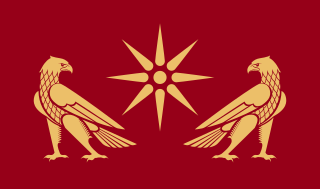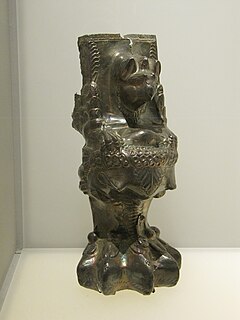The Arsacid Dynasty was an Iranian royal dynasty that ruled Parthia, in modern-day Iran, from 247 BC to 224 AD.
Arsacid dynasty may also refer to:

Caucasian Albania is a modern exonym for a former state located in ancient times in the Caucasus: mostly in what is now Azerbaijan. The modern endonyms for the area are Aghwank and Aluank, among the Udi people, who regard themselves as descended from the inhabitants of Caucasian Albania. However, its original endonym is unknown.

In Greco-Roman geography, Iberia was an exonym for the Georgian kingdom of Kartli, known after its core province, which during Classical Antiquity and the Early Middle Ages was a significant monarchy in the Caucasus, either as an independent state or as a dependent of larger empires, notably the Sassanid and Roman empires. Iberia, centered on present-day Eastern Georgia, was bordered by Colchis in the west, Caucasian Albania in the east and Armenia in the south.

The South Caucasus, also known as Transcaucasia, is a geographical region on the border of Eastern Europe and Western Asia, straddling the southern Caucasus Mountains. The South Caucasus roughly corresponds to modern Armenia, Georgia, and Azerbaijan, which are sometimes collectively known as the Caucasian States. The total area of these countries measures about 186,100 square kilometres. The South Caucasus and the North Caucasus together comprise the larger Caucasus geographical region that divides Eurasia.

Artsakh was the tenth province (nahang) of the Kingdom of Armenia from 189 BC until 387 AD and afterwards made part of the Caucasian Albanian satrapy of Sasanid Persia from 387 to the 7th century following the Peace of Acilisene. From the 7th to 9th centuries, it fell under Arab control. In 821, it formed the Armenian principality of Khachen and around the year 1000 was proclaimed the Kingdom of Artsakh, one of the last medieval eastern Armenian kingdoms and principalities to maintain its autonomy following the Turkic invasions of the 11th to 14th centuries.

Mirian III was a king of Iberia or Kartli (Georgia), contemporaneous to the Roman emperor Constantine the Great. He was the founder of the royal Chosroid dynasty.

The Kingdom of Armenia, also the Kingdom of Greater Armenia, or simply Greater Armenia, sometimes referred to as the Armenian Empire, was a monarchy in the Ancient Near East which existed from 321 BC to 428 AD. Its history is divided into successive reigns by three royal dynasties: Orontid, Artaxiad and Arsacid (52–428).
Tiridates is a word of Iranian origin. It may refer to:
The Parthian language, also known as Arsacid Pahlavi and Pahlawānīg, is an extinct ancient Northwestern Iranian language spoken in Parthia, a region situated in present-day northeastern Iran and Turkmenistan. Parthian was the language of state of the Arsacid Parthian Empire, as well as of its eponymous branches of the Arsacid dynasty of Armenia, Arsacid dynasty of Iberia, and the Arsacid dynasty of Caucasian Albania.
Vache, sometimes written as Vatché or Vaché, is an Armenian given name, and may refer to:

The Mihranids were an Iranian family which ruled several regions of Caucasus from 330 to 821. They claimed to be of Sasanian Persian descent but were of Parthian origin.

Caucasian Albania was a kingdom in the Caucasus, which was under the suzerainty of the Sasanian Empire from 252 to 636.

The Chosroid dynasty, also known as the Iberian Mihranids, were a dynasty of the kings and later the presiding princes of the early Georgian state of Iberia from the 4th to the 9th centuries. The family, of Iranian Mihranid origin, accepted Christianity as their official religion c. 337, and maneuvered between the Byzantine Empire and Sassanid Iran to retain a degree of independence. After the abolition of the Iberian kingship by the Sassanids c. 580, the dynasty survived in its two closely related, but sometimes competing princely branches—the elder Chosroid and the younger Guaramid—down to the early ninth century when they were succeeded by the Georgian Bagratids on the throne of Iberia.

The Pharnavazid is the name of the first dynasty of Georgian kings of Kartli (Iberia) preserved by The Georgian Chronicles. Their rule lasted, with intermissions, from the 3rd century BC to the 2nd century AD. The main male line is reported to have become extinct early on and followed by houses related to it in the female line. By the close of the 2nd century AD, the Pharnavazid rule came to an end and the Arsacid Dynasty took over the crown of Iberia.
The House of Mihrān or House of Mehrān (new Persian: مهران), was a leading Iranian noble family (šahrdārān), one of the Seven Great Houses of the Sassanid Persian Empire which claimed descent from the earlier Arsacid dynasty. A branch of the family formed the Mihranid line of the kings of Caucasian Albania and the Chosroid Dynasty of Kartli.
The Arsacid dynasty or Arshakiani, a branch of the Arsacid dynasty of Parthia, ruled the ancient Kingdom of Iberia from c. 189 until 284 AD. The Arsacid dynasty of Iberia was succeeded by the Chosroid dynasty.
The Arsacid dynasty was a dynasty of Parthian origin, which ruled the kingdom of Caucasian Albania from the 3rd to the 6th century. They were a branch of the Arsacid dynasty of Parthia and together with the Arsacid rulers of the neighboring Armenia and Iberia formed a pan-Arsacid family federation.
Artaxias IV or Artashir IV who is also known as Artaxias, Artashes, Artashes IV, Artashir, Ardases, Ardasir and Artases was a prince who served as a Sassanid client king of eastern Armenia from 422 until 428. Artaxias IV was the last Arsacid king of Armenia and the last person to hold the crown of the ancient Armenian Kingdom.
Arshak is a Persian and Armenian given name.
Urnayr was the third Arsacid king of Caucasian Albania from approximately 350 to 375. He was the successor of Vache I.